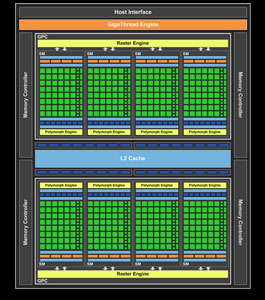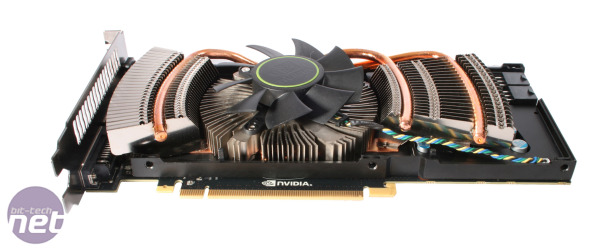
GeForce GTX 560 Ti Specifications
As with the GF110 GPU of the GeForce GTX 580 1.5GB, the GF114 GPU of the GTX 560 Ti 1GB sees the previously disabled final SM of the GF104 design enabled.This brings the total number of SMs to eight, and sees the stream processor count increase by 48 to a total of 384. However, as the basic architecture of the GPU is otherwise unchanged, the memory interface remains at 256 bits wide.
While the memory interface remains the same, the memory speed of the GTX 560 Ti 1GB has also received a meaningful increase in speed, jumping by 11 per cent in comparison to the GTX 460 range to 1GHz (4GHz effective).
The use of low leakage transistors for less performance-critical areas of the GPU has allowed Nvidia to push the GTX 560 Ti 1GB’s clock speeds up, but Nvidia has been surprisingly cautious here.
Stock-speed cards will ship with a GPU core speed of 820MHz core and a stream processor clock of 16,40MHz. This is an improvement of roughly 20 per cent over the original GTX 460 range, with frequencies lower than those of many pre-overclocked GTX 460 cards.
In comparison, the GTX 580 1.5GB received a 10 per cent jump in GPU frequency over the GTX 480 1.5GB while the GTX 570 1.3GB sports GPU frequencies that are 21 per cent higher than those of the GTX 470 1.3GB.
Despite the big jump, we suspect that Nvidia is holding back in the frequency department in order to allow card manufacturers plenty of opportunity to deliver a range of different cards – from bog-standard cards to mildly pre-overclocked ones to cards that could compete with the GTX 570 1.3GB. This could also allow GTX 560 Ti 1GB cards (of some form) to compete against the Radeon HD 6870 1GB and Radeon HD 6950 2GB. We’ll be paying special attention to how well the GTX 560 Ti 1GB overclocks, especially as given the excellent overclocking pedigree of the GTX 460.
Nvidia’s reference card design looks very similar to that of the GTX 460, but there are some subtle tweaks. While the PCB is still only 9in long, and there are still two dual-link DVI and a single mini-HDMI outputs, the reference cooler has been revised and now features a third copper heatpipe running through an elaborate array of aluminium cooling fins mounted atop the GPU.
Click to enlarge
Nvidia has also added an aluminium plate to cool the card’s GDDR5 memory and power circuitry. We hear that some card manufacturers will forgo this, even for overclocked cards.
Power is still delivered by two 6-pin PCI-E power connectors, and the GTX 560 Ti 1GB shares the same power management technology of the GTX 580 1.5GB and GTX 570 1.3GB. This aims to prevent excessive power draw by lowering the frequency of the GPU when the driver detects applications that would otherwise push the card beyond its safe power draw limit. We’ve not found this to interrupt our overclocking or power testing methods as we use games and realistic benchmarks to stress test, but you’ll need to investigate the workaround if you want to use tools such as FurMark and OCCT.
| Nvidia GeForce GTX 570 1.5GB | ATI Radeon HD 6950 2GB | Nvidia GeForce GTX 560 Ti 1GB | ATI Radeon HD 6870 1GB | Nvidia GeForce GTX 460 1GB | |
| GPU | |||||
| Codename | GF110 | Cayman Pro | GF114 | Barts XT | GF104 |
| Frequency | 732MHz | 800MHz | 820MHz | 900MHz | 675MHz |
| Stream Processors | 480 (1,464MHz) | 1,408 (800MHz) | 384 (1,640MHz) | 1,120 (900MHz) | 336 (1,215MHz) |
| Layout | 15 SMs, 4 GPCs | 22 SIMD Engines | 8 SMs, 2GPCs | 14 SIMD Engines | 7 SMs, 2 GPCs |
| Rasterisers | 4 | 2 | 2 | 2 | 2 |
| Tesselation Units | 15 | 2 | 8 | 1 | 7 |
| Texture Units | 60 | 88 | 64 | 56 | 56 |
| ROPs | 40 | 32 | 32 | 32 | 28 |
| Transistors | 3bn | 2.6bn | 1.95bn | 1.7bn | 1.95bn |
| Size | Unknown | Unknown | Unknown | 255mm2 | Unknown |
| Process | 40nm | 40nm | 40nm | 40nm | 40nm |
| Memory | |||||
| Amount | 1,280MB GDDR5 | 2GB GDDR5 | 1GB GDDR5 | 1GB GDDR5 | 1GB GDDR5 |
| Frequency | 950MHz (3.8GHz effective) | 1.25GHz (5GHz effective) | 1GHz (4GHz effective) | 1,050MHz (4.2GHz effective) | 900MHz (3.6GHz effective) |
| Interface | 320-bit | 256-bit | 256-bit | 256-bit | 256-bit |
| Bandwidth | 152GB/sec | 160GB/sec | 128GB/sec | 134.4GB/sec | 115GB/sec |
| Card Specifications | |||||
| Power Connectors | 2 x 6-pin PCI-E | 2 x 6-pin PCI-E | 2 x 6-pin PCI-E | 2 x 6-pin PCI-E | 2 x 6-pin PCI-E |
| Maximum Power Draw | 219W | 225W | 180 | 151W | 160W |
| Idle Power Draw | Unknown | Unknown | Unknown | 19W | Unknown |
| Recommended PSU | 550W | Unknown | 500W | Unknown | 450W |
| Typical Street Price | £300 | £235 | £199 | £180 | £155 |

MSI MPG Velox 100R Chassis Review
October 14 2021 | 15:04











Want to comment? Please log in.